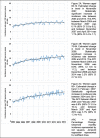Incidence and antibiotic prescribing for clinically diagnosed urinary tract infection in older adults in UK primary care, 2004-2014
- PMID: 29304056
- PMCID: PMC5755802
- DOI: 10.1371/journal.pone.0190521
Incidence and antibiotic prescribing for clinically diagnosed urinary tract infection in older adults in UK primary care, 2004-2014
Abstract
Urinary tract infections (UTI) are an important cause of morbidity and antibiotic use in older adults but there are little data describing disease burden in primary care. The aim of this study was to estimate the incidence of clinically diagnosed UTI and examine associated empirical antibiotic prescribing. We conducted a retrospective observational study using linked health records from almost one million patients aged ≥65 years old, registered with 393 primary care practices in England. We estimated incidence of clinically diagnosed UTI between March 2004 and April 2014, and used multilevel logistic regression to examine trends in empiric antibiotic prescribing. Of 931,945 older adults, 196,358 (21%) had at least one clinically diagnosed UTI over the study period. In men, the incidence of clinically diagnosed UTI per 100 person-years at risk increased from 2.81 to 3.05 in those aged 65-74, 5.90 to 6.13 in those aged 75-84, and 8.08 to 10.54 in those aged 85+. In women, incidence increased from 9.03 to 10.96 in those aged 65-74, 11.35 to 14.34 in those aged 75-84, and 14.65 to 19.80 in those aged 85+. Prescribing of broad-spectrum antibiotics decreased over the study period. There were increases in the proportion of older men (from 45% to 74%) and women (from 55% to 82%) with UTI, prescribed a UTI specific antibiotic. There were also increases in the proportion of older men (42% to 69%) and women (15% to 26%) prescribed antibiotics for durations recommended by clinical guidelines. This is the first population-based study describing the burden of UTI in UK primary care. Our findings suggest a need to better understand reasons for increasing rates of clinically diagnosed UTI and consider how best to address this important clinical problem.
Conflict of interest statement
Figures




References
-
- Caljouw MAA, den Elzen WPJ, Cools HJM, Gussekloo J. Predictive factors of urinary tract infections among the oldest old in the general population. A population-based prospective follow-up study. BMC Medicine. 2011;9 (no pagination)(57). PubMed doi: 10.1186/1741-7015-9-57 . - DOI - PMC - PubMed
-
- McDonald HI, Nitsch D, Millett ER, Sinclair A, Thomas SL. New estimates of the burden of acute community-acquired infections among older people with diabetes mellitus: a retrospective cohort study using linked electronic health records. Diabet Med. 2014;31(5):606–14. Epub 2013/12/18. doi: 10.1111/dme.12384 ; PubMed Central PMCID: PMCPmc4264938. - DOI - PMC - PubMed
-
- Juthani-Mehta M, Quagliarello V, Perrelli E, Towle V, Van Ness PH, Tinetti M. Clinical features to identify urinary tract infection in nursing home residents: a cohort study. J Am Geriatr Soc. 2009;57(6):963–70. Epub 2009/06/06. doi: 10.1111/j.1532-5415.2009.02227.x PubMed Central PMCID: PMCPmc2692075. - DOI - PMC - PubMed
-
- Hood K, Nuttall J, Gillespie D, Shepherd V, Wood F, Duncan D, et al. Probiotics for Antibiotic-Associated Diarrhoea (PAAD): a prospective observational study of antibiotic-associated diarrhoea (including Clostridium difficile-associated diarrhoea) in care homes. Health Technol Assess. 2014;18(63):1–84. Epub 2014/10/22. doi: 10.3310/hta18630 . - DOI - PMC - PubMed
-
- McClean P, Tunney M, Gilpin D, Parsons C, Hughes C. Antimicrobial prescribing in residential homes. J Antimicrob Chemother. 2012;67(7):1781–90. Epub 2012/03/23. doi: 10.1093/jac/dks085 - DOI - PubMed
Publication types
MeSH terms
Substances
Grants and funding
LinkOut - more resources
Full Text Sources
Other Literature Sources
Medical
Miscellaneous

